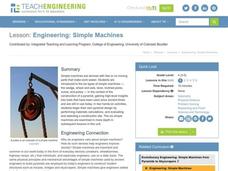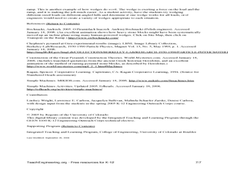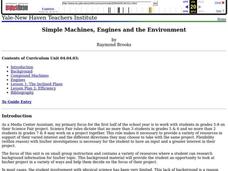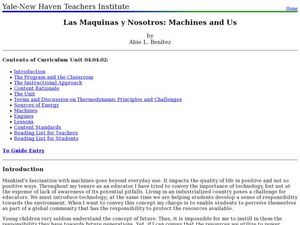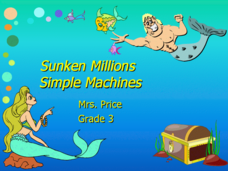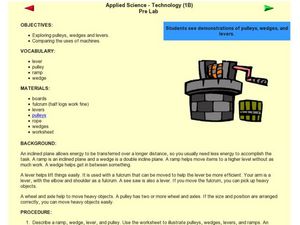Curated OER
Simple Machines Challenge
In this simple machines facts worksheet, students respond to 6 multiple choice questions that require them to exhibit what they know about simple machines.
Curated OER
Simple Machines Crossword
In this simple machines crossword puzzle worksheet, students use the 6 clues and the terms in the word bank to help them correctly complete the word puzzle.
Curated OER
Simple Machines Vocabulary Worksheet
In this simple machines learning exercise, students read ten definitions of words that pertain to simple machines. Students match the meanings with the vocabulary words in a word box.
Curated OER
Simple Machines
Here is a good four-page instructional activity designed to get your young inventors thinking about a simple machine they could design and build. They must answer some basic questions about their machine, draw a sketch of their idea, and...
Curated OER
Simple Machines
Fourth graders investigate and explore the inner workings of objects that help us do work. They examine how the parts work together to make the object function. Using the internet, 4th graders discover the interaction of the parts of a...
Curated OER
Levers and Pulleys
Seventeen pages of material leave you well-prepared to carry out this lesson on levers and pulleys. Photos and diagrams make the instructions clear; resource links provide additional information. The missing aspects of this teacher's...
Curated OER
Simple Machines
Students create a pyramid design based on the 6 simple machines that they are introduced to. In this simple machines lesson plan, students are introduced to the wedge, wheel and axle, inclined plane, screw, and pulley.
Curated OER
Pyramid Building: How to Use a Wedge
Students explore the simple machine of a wedge. For this wedge lesson, students test wedges on different materials including wax, soap, clay and foam. They learn how a wedge was used to build the ancient pyramid and modern day skyscrapers.
Curated OER
Simple Machines
Eighth graders work together in groups to introduce themselves to the six types of simple machines. They are to record what the machine does, its mechanical advantage and identify real world situations in which they are used. They...
Curated OER
Newton's Second Law of Motion with Simple Machines
First graders study Newton's Second Law of Motion before demonstrating the concept with a simple machine. They sing a song about speed, force, mass, and acceleration. They use simple machines to demonstrate how objects that have a higher...
Curated OER
Notes on the Screw
In this notes on the screw worksheet, 5th graders read 3 paragraphs about the screw, its history and uses, then write the main points of each paragraph in the right hand column.
Curated OER
Matching Types of Simple Machines
In this matching types of simple machines worksheet, 5th graders read the definition and examples of simple machines, then match 10 pictures of devices with 4 categories.
Curated OER
Teaching About Simple Machines
Students identify six different simple machines. They investigate the difference between the ideal and actual mechanical advantage. Students calculate the actual mechanical advantage for several simple machines.
Curated OER
Simple Machines
Students examine six simple machines and investigate who Rube Goldberg is. They explore various websites, write an article, write ten interesting facts about Rube Goldberg, and design and construct a simple machine.
Curated OER
Simple Machines, Engines and the Environment
Fourth graders calculate the mechanical advantage of an inclined plane. In this physics lesson plan, 4th graders identify the different types of simple machines and their uses. They give examples of compound machines.
Curated OER
Las Maquinas y Nosotros: Machines and Us
Second graders explain the relationship between energy and work. In this technology lesson, 2nd graders describe the different uses of machines in their everyday lives. They record observations and data in their science journal.
Curated OER
Sunken Millions Simple Machines
This PowerPoint includes a quiz show game in which two teams compete for points received by answering questions about simple machines. The content reviewed includes the types of simple machines, identifying examples of simple machines...
Curated OER
Simple Machines: The Wede & Lever
Students describe how wedge and lever makes work easier. In this physics instructional activity, students analyze experimental data by creating a graph to see the trends. They calculate the work done and mechanical advantage of these...
Curated OER
Inclined Plane and Pulley
Students describe how inclined plane and pulleys make work easier. In this physics lesson, students calculate work done and mechanical advantage of both simple machines. They collect data from the experiment and construct graphs.
Curated OER
Move It! With Simple Machines
Young scholars explore engineering by participating in a mechanical class activity. In this simple machines lesson, students identify many simple machines that allow them to perform tasks easily each day. Young scholars collaborate in...
Curated OER
Simple Machines Worksheet
In this simple machines worksheet, students complete a chart. They look at a picture of a simple machine, draw/paste an example of each one for homework. They use a web quest to find 2 more facts about each one and write it in the chart....
Curated OER
Applied Science - Technology (1B) Pre Lab
First graders explore simple machines. For this technology lesson, 1st graders review pulleys, levers, wedges, and ramps. They experiment with lifting items with and without these simple machines.
Curated OER
Applied Science - Technology (2A) Lab
Second graders experiment with simple machines. In this machine instructional activity, 2nd graders go to different labs to see examples of a lever, inclined plane, wedge, pulley, gears, and wheel and axle. They discuss how a machine...
Curated OER
Applied Science - Technology (2A) Post Lab
Second graders explore simple machines. For this technology lesson, 2nd graders look at pulleys and gears and what the uses are for each. They complete a worksheet comparing the two.








